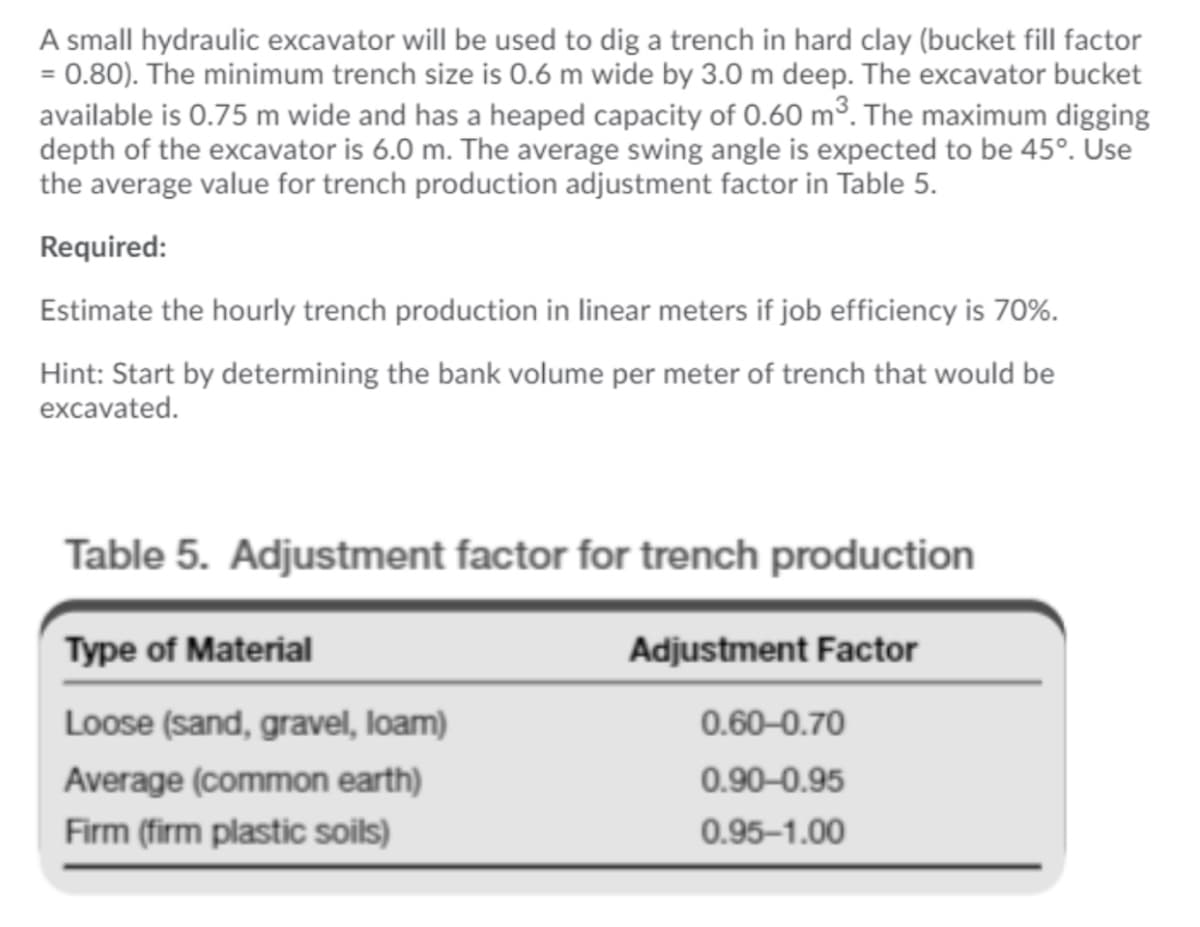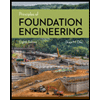A small hydraulic excavator will be used to dig a trench in hard clay (bucket fill factor = 0.80). The minimum trench size is 0.6 m wide by 3.0 m deep. The excavator bucket available is 0.75 m wide and has a heaped capacity of 0.60 m³. The maximum digging depth of the excavator is 6.0 m. The average swing angle is expected to be 45°. Use the average value for trench production adjustment factor in Table 5. Required: Estimate the hourly trench production in linear meters if job efficiency is 70%. Hint: Start by determining the bank volume per meter of trench that would be excavated.
A small hydraulic excavator will be used to dig a trench in hard clay (bucket fill factor = 0.80). The minimum trench size is 0.6 m wide by 3.0 m deep. The excavator bucket available is 0.75 m wide and has a heaped capacity of 0.60 m³. The maximum digging depth of the excavator is 6.0 m. The average swing angle is expected to be 45°. Use the average value for trench production adjustment factor in Table 5. Required: Estimate the hourly trench production in linear meters if job efficiency is 70%. Hint: Start by determining the bank volume per meter of trench that would be excavated.
Fundamentals of Geotechnical Engineering (MindTap Course List)
5th Edition
ISBN:9781305635180
Author:Braja M. Das, Nagaratnam Sivakugan
Publisher:Braja M. Das, Nagaratnam Sivakugan
Chapter15: Retaining Walls, Braced Cuts, And Sheet Pile Walls
Section: Chapter Questions
Problem 15.24P
Related questions
Question

Transcribed Image Text:A small hydraulic excavator will be used to dig a trench in hard clay (bucket fill factor
= 0.80). The minimum trench size is 0.6 m wide by 3.0 m deep. The excavator bucket
available is 0.75 m wide and has a heaped capacity of 0.60 m³. The maximum digging
depth of the excavator is 6.0 m. The average swing angle is expected to be 45°. Use
the average value for trench production adjustment factor in Table 5.
Required:
Estimate the hourly trench production in linear meters if job efficiency is 70%.
Hint: Start by determining the bank volume per meter of trench that would be
excavated.
Table 5. Adjustment factor for trench production
Type of Material
Adjustment Factor
Loose (sand, gravel, loam)
0.60-0.70
Average (common earth)
0.90–0.95
Firm (firm plastic soils)
0.95-1.00
Expert Solution
This question has been solved!
Explore an expertly crafted, step-by-step solution for a thorough understanding of key concepts.
This is a popular solution!
Trending now
This is a popular solution!
Step by step
Solved in 2 steps

Knowledge Booster
Learn more about
Need a deep-dive on the concept behind this application? Look no further. Learn more about this topic, civil-engineering and related others by exploring similar questions and additional content below.Recommended textbooks for you

Fundamentals of Geotechnical Engineering (MindTap…
Civil Engineering
ISBN:
9781305635180
Author:
Braja M. Das, Nagaratnam Sivakugan
Publisher:
Cengage Learning

Principles of Foundation Engineering (MindTap Cou…
Civil Engineering
ISBN:
9781337705028
Author:
Braja M. Das, Nagaratnam Sivakugan
Publisher:
Cengage Learning

Principles of Geotechnical Engineering (MindTap C…
Civil Engineering
ISBN:
9781305970939
Author:
Braja M. Das, Khaled Sobhan
Publisher:
Cengage Learning

Fundamentals of Geotechnical Engineering (MindTap…
Civil Engineering
ISBN:
9781305635180
Author:
Braja M. Das, Nagaratnam Sivakugan
Publisher:
Cengage Learning

Principles of Foundation Engineering (MindTap Cou…
Civil Engineering
ISBN:
9781337705028
Author:
Braja M. Das, Nagaratnam Sivakugan
Publisher:
Cengage Learning

Principles of Geotechnical Engineering (MindTap C…
Civil Engineering
ISBN:
9781305970939
Author:
Braja M. Das, Khaled Sobhan
Publisher:
Cengage Learning

Principles of Foundation Engineering (MindTap Cou…
Civil Engineering
ISBN:
9781305081550
Author:
Braja M. Das
Publisher:
Cengage Learning